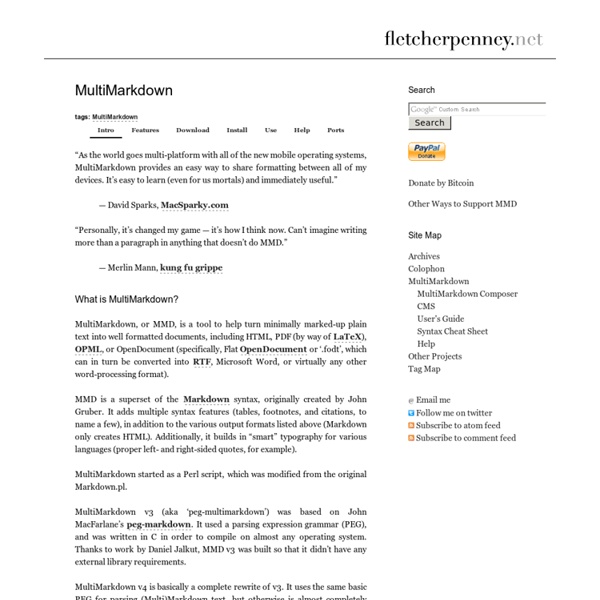MultiMarkdown

Ultimate Markdown Maestro Guide
Updated on: July 22, 2013 at 00:00 Outline Introduction Once you have started with Markdown it is likely that you will come to a point where it is indispensable. I have a lot of Keyboard Maestro macros and a good deal of them is there for editing text, which means for me: editing Markdown. This article is about how I organize my macro library and what tools I use for writing Markdown. The Goal I want everybody who is willing to write in Markdown and has no idea how to make use of Keyboard Maestro to get inspired and give them some ideas how to use the program. To give you a teaser I prepared a short overview in form of a video to let you decide later on which parts of this article you are interested in: If this is more than you need you can trim it down till your requirements are met. If you’re already sold then read on before your head on to download everything because there are a lot of dependencies: services to be installed, scripts to put in the right location, etc. Organization Folders ! !
Markdown By Example by Tim Steinbach
Markdown By Example - The book for Markdown-everything. From text files over presentations to blogs, it can all be done using mostly Markdown. And it is easy, too! This book introduces the reader to the Markdown syntax, teaches a few tricks on output styling and explains the various tools and frameworks that support Markdown. All this is done using an imaginary monitoring tool called "GoodTool", which - by the end of the book - has a README file, a website, a blog, a wiki and much more. Finally, the book ends in a chapter explaining the "Making Of Markdown By Example" - yes, this book is not only about Markdown, it was also written in Markdown! The first edition of this book has been completed! Second edition plans: Add instructions for Windows for all tools compatibleAdd more imagesCreate interactive iPad companion book (created with iBooks Author, will be free) If you have any feedback concerning the second edition plans, please do not hesitate to contact the author!
Markdown Guide – DAY ONE / SUPPORT
Markdown Information Markdown, created by John Gruber of Daring Fireball, is the technology we chose to use to allow rich text within Day One journal entries. Markdown allows italic and bold, along with several other simple formatting options that can be written using plain text and display properly in Read views. Markdown syntax is available in Day One and is toggled On by default. Day One takes a similar approach to Markdown as GitHub. See GitHub Flavored Markdown. The best way to see how Markdown formatting works in Day One is to refer to these sample entries: Day One Markdown Sample (.text file)Day One Markdown Sample (.text file with blockquote explanations) Day One Markdown Syntax Basics *italic* or _italic_ / **bold** or __bold__ italic or italic / bold or bold An inline link: [example]( An inline link: example. An id link [example][id]. An id link example. An auto-linked URL: Headers Header 3 Header 4 Header 5 Header 6 Lists 1. 1. !
CriticMarkup
CriticMarkup was designed to make plain text copyediting markup easy to write and easy to read. What follows is a short overview of the CriticMarkup syntax. If you’re looking for more detailed information on how CriticMarkup renders its syntax into pure HTML, see the spec page. The Basic Syntax There are five types of Critic marks: Addition {++ ++}Deletion {-- --}Substitution {~~ ~> ~~}Comment Highlight {== ==} We’ll go over each of these marks in turn. Additions You make a CriticMarkup addition by surrounding the new text with curly braces and double plus marks. Lorem ipsum dolor{++ sit++} amet… A space character and “sit” will be inserted at the position shown. Deletions Deletions use a similar syntax. Lorem{-- ipsum--} dolor sit amet… The word “ipsum” and a leading space character are marked for deletion in the above example. Substitutions Substitutions combine a deletion with an addition in one snippet, and are written as matched curly braces and double tildes. Lorem ipsum dolor sit amet.
Heck Yes Markdown
Markdown Here
Pandoc - About pandoc
Markdown and including multiple files - Stack Overflow
Related:
Related:



